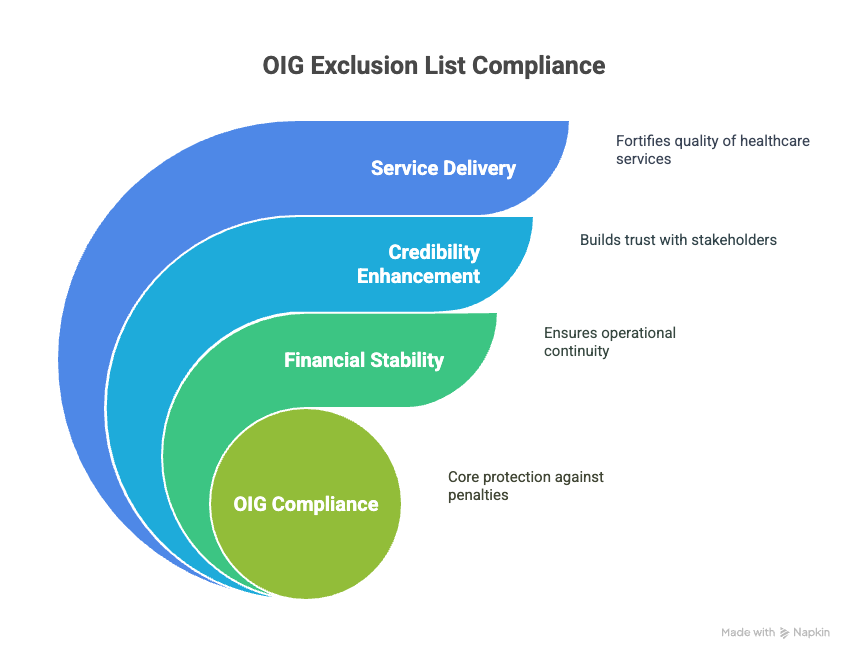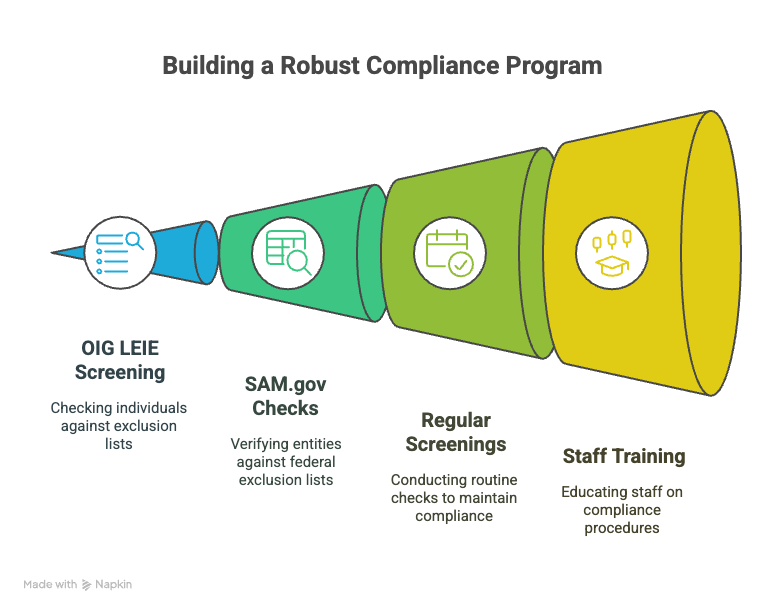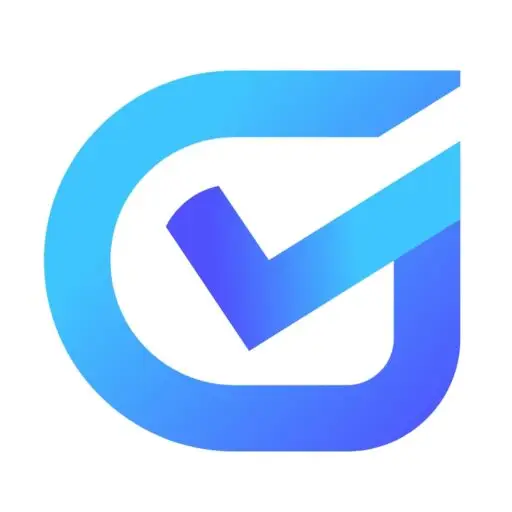Navigating the intricate realm of exclusion screening can often feel like deciphering a complex puzzle. This guide is designed to streamline the process of understanding and meeting the stringent regulations surrounding the Office of Inspector General (OIG) and System for Award Management (SAM) exclusion screening rules. Whether you're a healthcare provider, HR professional, or compliance officer, staying current with these requirements is essential to avoid hefty penalties and ensure smooth operations.
In this comprehensive guide, we'll delve into the specifics of OIG exclusion list compliance, the significance of SAM checks in healthcare, and the critical necessity of monthly exclusion monitoring. Leveraging both primary and secondary keywords throughout, this text will offer practical insights and actionable steps to align with federal exclusion compliance standards.
Key Takeaways
- Regularly checking OIG and SAM exclusion lists is crucial for avoiding financial penalties and preserving your organization's reputation in healthcare.
- Understanding the roles of the OIG and SAM exclusion lists helps prevent hiring individuals barred from federal healthcare programs.
- Non-compliance with exclusion rules can result in costly fines and a loss of access to federal funds, highlighting the importance of consistent screening.
- A strong compliance program includes regular screenings, designated staff, and proper documentation to safeguard against hiring excluded parties.
- Monthly checks and automation tools are vital for efficient exclusion monitoring, keeping your organization aligned with federal requirements.
Introduction
A few years back, a major hospital found itself in hot water. They failed to adhere to exclusion screening rules and employed an individual banned under the OIG exclusion list. The result? Monetary penalties that cut into their budget and a tarnished reputation. This incident highlights the critical role of regularly checking OIG and SAM exclusion lists in healthcare.
Exclusion screening rules ensure that those barred from participating in federally funded healthcare programs don't sneak through the cracks. These regulations are crucial for healthcare providers, HR personnel, and compliance officers who need to prevent deals with sanctioned parties. The financial impact of non-compliance can be severe, but the blow to your organization's credibility might be worse.
This guide dives into why staying compliant with OIG and SAM regulations holds immense value. You'll learn about key compliance requirements, effective strategies, and practical tools to manage them efficiently. Whether you want to avoid penalties or boost your organization's credibility, understanding these rules is a must. Let's break down how you can align with federal exclusion standards without unnecessary headaches.
Understanding the Basics: OIG and SAM Exclusion Explained
When it comes to exclusion screening, understanding the basics is essential. If you're responsible for compliance in the healthcare sector, you need to be well-versed with the OIG and SAM exclusion lists.
What is the OIG Exclusion List?
The OIG exclusion list is a federal list maintained by the Office of Inspector General. It includes names of individuals and entities banned from participating in federally funded healthcare programs. This list is part of the List of Excluded Individuals/Entities (LEIE). If someone is on this list, billing for any services they provide to Medicare or Medicaid can lead to significant penalties. Non-compliance can also result in reputational harm, something no healthcare provider can afford. For example, a hospital employing a doctor unknowingly listed on the LEIE may face fines and repayment obligations.
What is SAM.gov in Healthcare?
The System for Award Management (SAM) is another critical component in ensuring federal exclusion compliance. It's not just for checking vendors; healthcare providers must also ensure they aren’t engaging with excluded entities. SAM.gov consolidates the federal procurement systems and includes relevant exclusion data. By accessing SAM.gov, healthcare organizations can ensure they aren't violating federal guidelines. Think of it as another layer of precaution, protecting against possible financial and legal troubles. Checking SAM.gov regularly is like tightening all the bolts of a machine before starting it—you ensure everything is secure.
In brief, both the OIG and SAM lists require your attention. They serve different yet complementary roles in protecting the integrity of healthcare operations. Ignoring them isn't an option if you want to maintain a compliant and risk-free organization.
The Importance of OIG Exclusion List Compliance
Neglecting OIG exclusion rules can have serious consequences. Imagine running a healthcare facility that unknowingly hires an excluded individual. The legal and financial hits could cripple your operations. You risk hefty fines, repayment of funds, and the freezing of your business activities. These aren't just theoretical risks; they are harsh realities faced by many organizations that dropped the ball on compliance.
Consider the case of a mid-sized hospital that missed a monthly check. An employee on their payroll was discovered to be on the OIG exclusion list. The oversight cost them nearly $3 million in penalties and barred them from accessing certain federal funds for a time. It's a stark reminder of why constant vigilance is necessary.
Yet, there's an upside to all this. Compliance with OIG rules not only protects your organization from penalties but also boosts your reputation. It signals to your patients, partners, and regulators that you prioritize integrity and quality. Staying compliant reassures all stakeholders that your operations are trustworthy and above board.

So why gamble with your organization's future? Compliance might require effort, but it's a worthy investment. It secures your financial stability, enhances your credibility, and ultimately, fortifies your service delivery. Ready to make compliance your top priority?
Elements of a Robust Compliance Program
Creating a solid compliance program begins with effective OIG LEIE screening. This process involves checking the List of Excluded Individuals/Entities to ensure no employed individuals or entities are barred from federal healthcare programs. Conducting regular screenings prevents unintentional hiring of excluded parties, which could result in penalties. For successful implementation, create a streamlined process. Designate specific staff to handle screenings, set clear timelines, and maintain thorough records. Document each step. This helps verify compliance and can defend your organization if discrepancies arise.

Next, focus on SAM.gov checks specific to healthcare. This involves verifying entities against federal exclusion lists. Start by accessing the SAM database. Search for any changes in the exclusion status of vendors or employees. Interpret the results carefully—an exclusion doesn't just mean termination; it might require suspension or additional investigation. Take action based on findings. If an exclusion is detected, consult your legal team to decide the best course of action.
Consistency in these screenings is key. Establish a schedule to perform these checks routinely. Whether monthly or quarterly, frequent checks reduce risks of non-compliance. Use software to automate these processes, minimizing human error and saving time. By integrating technology, compliance becomes more manageable and less prone to oversight.
An actionable program also considers training. Educate your team about the importance of exclusion screenings. Regular refresher courses keep the process top-of-mind. This creates a culture of compliance where everyone knows their role in protecting the organization from potential violations.
Every step taken to fortify your compliance program builds a stronger foundation for meeting OIG and SAM exclusion rules. What steps can you implement today to enhance your organization's compliance efforts?
OIG Background Check Rules and Monthly Exclusion Monitoring
Regular monthly checks are the backbone of a compliant exclusion monitoring program. By committing to a monthly schedule, you align with federal guidelines, reduce risk, and maintain trust. Consistently checking the List of Excluded Individuals and Entities (LEIE) can protect your organization from hefty fines and the reputational damage that non-compliance can bring.
Implement tools to automate these checks if you can. Automated systems optimize accuracy and efficiency, saving you time and reducing human error. Options like third-party services or specialized software can streamline this process, ensuring you remain compliant without the administrative headache.
Creating a compliance checklist is another practical step. Start by defining the goals specific to your organization. Tailor the checklist to include elements such as scheduling regular checks, maintaining documentation, and designating responsible personnel for oversight. Incorporating these steps into your routine enhances your compliance efforts, ensuring that you stay ahead of any regulatory changes.
Are your current processes enough to meet the demands of OIG exclusion compliance? Reassessing and updating your procedures regularly is crucial in safeguarding your organization's operations.
Legal Guidelines and Considerations
Understanding the legal landscape of exclusion screening in healthcare is crucial for compliance. Federal guidelines provide a framework ensuring fair and consistent practices. Agencies like the Equal Employment Opportunity Commission (EEOC) offer valuable resources. Their guidance shapes how exclusion screenings mesh with broader employment practices, emphasizing non-discrimination. It's wise to consult their guidelines to align your procedures.
Non-compliance in exclusion screening can lead to significant penalties. Addressing findings swiftly and thoroughly is crucial. Begin with documenting discrepancies. Write down what was found, when, and who is involved. This record is essential for audits. Next, communicate the issue to relevant parties within your organization. Develop a plan to remedy these findings quickly. Corrective measures might include retraining employees, revisiting compliance procedures, or consulting legal counsel. Following these steps not only mitigates risks but also strengthens your organization's compliance posture in the long term.
Best Practices for Exclusion Screening
Implementing exclusion screening effectively in your organization is crucial. Here's how you can make it a seamless part of your operations.
Implementing Effective Policies
Integrating exclusion screening into your HR and compliance strategies requires clarity and consistency. Start by drafting clear policies that outline the steps and responsibilities for exclusion checks. It's important to document each stage of the screening process, from the initial search of the OIG and SAM databases to any follow-up activities. Ensure your policies specify who conducts the screenings, how often they're done, and how results are documented and stored.
For instance, you can set a policy for monthly checks of all employees and contractors against both the OIG and SAM exclusion lists. Assign specific team members to carry out these checks, and provide them with detailed instructions on accessing and interpreting the lists. Remember, consistency is vital—each employee in a similar role should be subject to the same frequency and thoroughness of checks.
Training and Education
Continuous training plays a vital role in keeping your staff up-to-date with compliance activities. Schedule regular training sessions to ensure that your team understands both the importance and the process of exclusion screening. This training should cover how to access OIG and SAM databases, how to interpret the results, and the steps to take if a match is found.
For example, if your organization uses software to aid in exclusion screenings, make sure your team is well-versed in using these tools. This minimizes the risk of errors and ensures the process is efficient. Also, consider periodic refresher courses and updates whenever there are changes in federal regulations or tools you use.
Ultimately, prevention is better than cure. By investing in robust policies and comprehensive training, you reduce the risk of non-compliance. This, in turn, protects your organization from legal pitfalls and bolsters your standing in the healthcare field. How will you update your current practices to ensure compliance?
Conclusion
Meeting OIG and SAM exclusion screening rules is not simply a bureaucratic exercise; it's a fundamental practice that safeguards your organization and patients. Adhering to these guidelines means you can avoid hefty penalties, protect your organization's reputation, and ensure smooth operations.
Sticking to the outlined steps and best practices discussed in this guide—such as regular OIG LEIE and SAM.gov checks, documenting processes, and applying legal guidelines—sets a solid foundation for compliance. Monthly exclusion monitoring is not just a task but a strategy to maintain alignment with federal requirements continuously. Developing a compliance checklist tailored to your needs can streamline this process.
Taking proactive measures is crucial. Keeping your team informed and well-trained prevents costly mistakes and underscores your commitment to ethical standards. Staying up-to-date with regulatory updates ensures your practices are both current and compliant. You're not only protecting your organization but also fostering trust and integrity within the healthcare sector. Compliance isn't a one-time effort—it's an ongoing commitment that defines the quality and reliability of your organization.
Frequently Asked Questions (FAQs)
What is the OIG exclusion list used for?
The OIG exclusion list identifies individuals and entities prohibited from participating in federally funded healthcare programs due to fraudulent activity or misconduct.
Who must be screened against the OIG and SAM lists?
Healthcare providers and organizations must screen current and potential employees, contractors, and vendors to ensure compliance with federal regulations.
How often should exclusion checks be done?
It's best to perform exclusion checks monthly to ensure compliance and avoid penalties from engaging with excluded individuals or entities.
What happens if I hire someone on the OIG list?
If you hire someone on the OIG exclusion list, your organization risks significant fines, the potential loss of federal program funding, and possible legal action.
Are there tools that automate exclusion list screening?
Yes, several software solutions can automate the screening process, making it easier to regularly check for excluded individuals and entities.
How can I access the OIG exclusion list?
You can access the OIG exclusion list online through the OIG’s official website, and search by individual or entity name.
What is the SAM list?
The SAM list is a federal database that includes individuals and entities that are debarred, suspended, or otherwise excluded from receiving federal funds.
Why is it important to check the SAM list in addition to the OIG list?
Checking both lists ensures comprehensive compliance, as they cover different exclusions and are maintained by separate federal agencies.
What are the consequences of not screening against exclusion lists?
Failing to screen can lead to financial penalties, loss of federal contracts, and damage to your organization’s reputation.
Can individuals appeal an exclusion from the OIG list?
Yes, individuals have the right to appeal their exclusion and potentially have their name removed if they meet specific criteria outlined by the OIG.
Definitions
Exclusion Screening
Exclusion screening is the process of checking individuals and entities against federal databases, such as the OIG and SAM exclusion lists, to confirm they are not barred from participating in federally funded healthcare programs. This helps HR and compliance teams avoid hiring or working with sanctioned individuals, reducing legal, financial, and reputational risks.
OIG Exclusion List (LEIE)
The OIG exclusion list, known as the List of Excluded Individuals/Entities (LEIE), is a database maintained by the Office of Inspector General. It contains names of people and organizations banned from participating in Medicare, Medicaid, or other federal programs. Healthcare employers use this list to avoid hiring excluded parties.
SAM.gov
SAM.gov is the federal government’s official website for managing data on vendors, contractors, and individuals doing business with or receiving funds from the government. Healthcare organizations check this system to verify that their business partners or staff are not banned from federal programs.
Monthly Exclusion Monitoring
Monthly exclusion monitoring means checking the OIG and SAM exclusion lists every month to stay compliant with federal rules. This regular habit helps organizations detect any changes in status early and avoid unintended partnerships with excluded individuals.
Compliance Program
A compliance program is a set of internal policies and procedures developed to ensure a healthcare organization follows legal and regulatory requirements. In this context, it includes steps like regular exclusion screenings, staff training, documentation, and response plans if exclusions are found.
References
- OIG Exclusions List Program: https://oig.hhs.gov/exclusions/
- 2025 Case Study, Payment Default and Exclusion: https://www.hipaajournal.com/payment-defaults-hhs-oig-exclusion-march-2025/
- OIG Exclusion List in Healthcare (Guides): https://compliancy-group.com/oig-exclusions-list/
- Summary of Exclusion Types and Periods: https://www.hipaajournal.com/hhs-oig-exclusions-list/
Still have questions?
Get in touch with our team today for a personalized demo and discover how our tailored volume pricing and packages can drive results for your business!
How useful was this page?*
Note: your comments are anonymous. We use them to improve the website. Do not include any personal details.
Visit our FCRA Compliance Tool or leave a message here if you need a response.
From the blog Explore the GCheck Content Hub

DOT Physical Requirements for Drivers: 2026 Compliance Guide
9 Jan, 2026 • 17 min read
Healthcare Employee Background Check: What Employers Need to Know in 2026
9 Jan, 2026 • 19 min read
How Long Do Background Checks Take for Government Jobs? Timeline Expectations for 2026
6 Jan, 2026 • 20 min readThe information provided in this article is for general informational and educational purposes only and should not be construed as legal advice or a substitute for consultation with qualified legal counsel. While we strive to ensure accuracy, employment screening laws and regulations—including but not limited to the Fair Credit Reporting Act (FCRA), Equal Employment Opportunity Commission (EEOC) guidelines, state and local ban-the-box laws, industry-specific requirements, and other applicable federal, state, and local statutes—are subject to frequent changes, varying interpretations, and jurisdiction-specific applications that may affect their implementation in your organization. Employers and screening decision-makers are solely responsible for ensuring their background check policies, procedures, and practices comply with all applicable laws and regulations relevant to their specific industry, location, and circumstances. We strongly recommend consulting with qualified employment law attorneys and compliance professionals before making hiring, tenant screening, or other decisions based on background check information.

